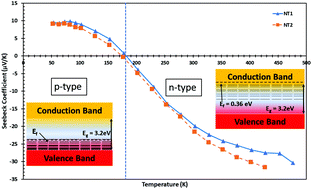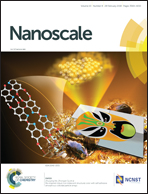Observation of a low temperature n–p transition in individual titania nanotubes†
Abstract
Manipulating the transport properties of titania nanotubes (NTs) is paramount in guaranteeing the material's successful implementation in various solid state applications. Here we present the unique semiconducting properties of individual titania NTs as revealed from thermoelectric and structural studies performed on the same individual NTs. The NTs were in the anatase phase fabricated by anodic oxidation and doped with intrinsic defects created by reducing the lattice thermally. Despite their polycrystalline nature and nanoscale walls, the doped NTs were found to be 4–5 orders of magnitude more electrically conducting than TiO2 nanowires and thin films, with values approaching the bulk single crystal conductivity. The reason for the high conductivity was found to be the high carrier concentration on the order of 1022 cm−3, which counteracted the low mobility values ∼0.006 cm2 V−1 s−1. Furthermore, this high level of carrier concentration transitioned the NTs to a degenerate state, which is the first such example in thermally doped titania NTs. More importantly, our study showed the creation of acceptor states along with donor states in individual nanotubes upon lattice reduction. These acceptor levels were found to be active at low temperatures when donor states were not ionized, shifting the Fermi level (Ef) from the conduction band to the valence band.



 Please wait while we load your content...
Please wait while we load your content...